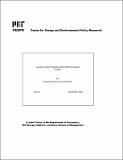| dc.contributor.author | Taschini, Luca | |
| dc.contributor.author | Grüll, Georg | |
| dc.date.accessioned | 2010-02-11T18:03:59Z | |
| dc.date.available | 2010-02-11T18:03:59Z | |
| dc.date.issued | 2009-11 | |
| dc.identifier.other | 2009-019 | |
| dc.identifier.uri | http://hdl.handle.net/1721.1/51718 | |
| dc.description.abstract | This paper examines the key design mechanisms of existing and proposed cap-and-trade markets. First, it is shown that the hybrid systems under investigation (safety-valve with offsets, price floor using a subsidy, price collar, allowance reserve, and options offered by the regulator) can be decomposed into a combination of an ordinary cap-and-trade scheme with European- or American-style call and put options. Then, we quantify and discuss the advantages and disadvantages of the proposed hybrid schemes by investigating whether pre-set objectives (enforcement of permit price bounds and reduction of potential costs for relevant companies) can be accomplished while maintaining the original environmental targets. | en |
| dc.description.sponsorship | Massachusetts Institute of Technology. Center for Energy and Environmental Policy Research. | en |
| dc.language.iso | en_US | en |
| dc.publisher | MIT Center for Energy and Environmental Policy Research | en |
| dc.relation.ispartofseries | MIT-CEEPR (Series);2009-019 | |
| dc.title | Cap-and-Trade Properties under Different Scheme Designs | en |
| dc.type | Working Paper | en |
